Beretta is a renowned Italian firearms manufacturer that produces some of the finest weapons ever designed. Italy has a long-standing tradition of crafting high-quality guns. In fact, two of the best weapons in my gun safe are Italian. The US Army and Navy also recognize this quality, having used the Beretta M9 as their standard-issue sidearm since 1985. Beretta’s success in the US market has led to the creation of a dedicated US division.
As an admirer of the civilian counterpart to the M9, the 92FS, I was excited to compare the Beretta M9 and the 92FS. These two guns share a nearly identical design, but they have some fascinating differences worth exploring.
BONUS OFFER: Get your free shooting range targets to print at home!
Get your free targets to print at home!
Beretta M9 vs 92FS Specs
| Pistol | Beretta M9 | Beretta 92FS |
|---|---|---|
| Action | Single/Double | Single/Double |
| Barrel Length | 125 mm (4.9 in) | 125 mm (4.9 in) |
| Caliber | 9×19mm Parabellum | 9×19mm Parabellum |
| Magazine | 15 rounds standard | 15 rounds standard |
| Width | 38 mm (1.5 in) | 38 mm (1.5 in) |
| Height | 137 mm (5.4 in) | 137 mm (5.4 in) |
| Weight Unloaded | 34.2 oz (970 g) | 33.3 oz (945 g) |
| Muzzle Velocity | 381 m/s (1,250 ft/s) | 381 m/s (1,250 ft/s) |
| Effective Firing Range | 50 m (160 ft) | 50 m (160 ft) |
| Feed System | Detachable box magazine | Detachable box magazine |
Can you spot the difference? The Beretta 92FS and the M9 look nearly identical, which isn’t surprising given their many shared specifications. Both fire 9mm ammo, can operate in single or double action, and have a barrel length of 4.9”, among other common features. Before exploring what sets them apart, let’s delve into the background of how these two exceptional guns were developed.
A Brief History of Beretta 92 Pistol
When it comes to purchasing a pistol, Beretta stands out as one of the oldest and most reputable gun manufacturers in the world. The company is located in the Val Trompia iron mining district of Italy.
The company was founded in the 16th century. As the oldest active firearms manufacturer in the world, Beretta has a long history, including the invention of the breech-loading cannon in 1650. They have since provided weapons for every major European war. Beretta provides firearms for military, police, and personal use and has supplied over 600,000 M9 handguns to the US military.
In 1976, Beretta introduced the Beretta 92 pistol, the design that serves as the foundation for both the 92FS and the M9. When the US military announced a competition to design a new sidearm for their forces, Beretta adapted the 92 into the M9 specifically for military use. They also created the civilian 92FS as a safer variant of the M9.
Popular Articles
The Beretta M9
The Beretta M9 is the ultimate combat and tactical pistol. It has been the standard sidearm of the United States Armed Forces since 1985. And is now utilized by the US Armed Forces across all branches.

The M9 Beretta service pistol has an overall length of 8.5 inches and a 4.9-inch chromed barrel. This duty weapon features a 9mm magazine with a 15+1 round capacity. The pistol is finished with a corrosion-resistant Bruniton matte black coating and includes polymer grip panels, ensuring effectiveness in any situation.
The Beretta M9 is a semi-automatic pistol known for its lightweight design. It incorporates multiple automatic safety systems to assist and prevent accidental firing. Additionally, it is designed for easy maintenance with fully interchangeable parts. The M9 utilizes a short recoil and a delayed locking block system.
In terms of 9mm handguns, the M9 is somewhat heavier and bulkier, making concealed carry potentially less comfortable. However, its added weight serves a practical purpose by reducing muzzle flip and recoil. Thus, allowing for quicker follow-up shots, especially in single-action mode.
To sum up, the Beretta M9 stands out as a legendary pistol valued for its reliability, accuracy, and durability. Field-tested over years of military service, this tactical handgun has proven its resilience in harsh conditions. Its distinctive style sets it apart, making it a highly attractive choice among sidearms.
- US Military tested
- Forward base grip for easier aiming
- The bore of the barrel is hard chromed
- External safety lever that is ambidextrous
- A bit bulky for concealed carry
The Beretta 92FS
The M9’s cousin, the 92FS, is one of the most durable pistols available. It is available in both double-action and single-action configurations as well. It includes a delayed locking-block system with a short-recoil that provides exceptional accuracy. Thus, it’s a dependable semi-automatic handgun that’s also popular for self-defense. The 92FS is a low-cost pistol that has long been the industry standard for tactical use.
Furthermore, the 92FS stands out with its unique design compared to other pistols. It is finished in Bruniton black coating. The inside of the barrel has a chromium lining that reduces wear and protects against corrosion.

The Beretta 92FS has proven to be a tough gun that has survived some of the harshest conditions. It can endure temperatures as low as -40°F up to 140°F. It has been tested rigorously in seawater, dirt, and snow. It just proves its reliability and resilience. You can rest assured that it is a weapon that is hard to beat.
Some limitations are the absence of a modern rail adapter, and the inability to add a pistol light to it. For some people with small hands, this gun may be difficult to wield due to its wide grip and long trigger reach. However, personally, I find it comfortable and manageable to use.
The decocker and the safety are both ambidextrous. The magazine release is placed in a convenient location for easy access. The 92FS comes with fixed tactical three-dot sights as standard. They make focusing on your intended aim a breeze. Yet, the three-dot sights have the disadvantage of being difficult to see in the dark.
Another safety feature of the 92FS is the red loaded chamber indicator. A chambered cartridge pushes up a red marker on the slide, indicating the firearm is loaded. The marker drops when the chamber is empty. Additionally, it also includes an exterior hammer so you can see if the gun is cocked.
- Ambidextrous safety/decocker
- Strong and durable pistol
- Resistant to harsh temperatures and can withstand -40°F to 140°F
- A corrosion-resistant chromed barrel
- Comes with three-dot sights
- There is no rail attachment
- The long trigger and grip are inconvenient for persons with small hands
Beretta M9 VS. 92FS – The Differences
At first glance, they appear quite similar. However, what sets them apart? Let’s delve into their specifications to uncover the differences.
Hammer
When examining the safety features, the distinctions between these firearms become evident. With the M9, there were incidents where the slide would unexpectedly shoot back toward the operator, posing a significant danger. In some cases, this resulted in the slide hitting a soldier in the face, which is highly undesirable during combat situations. To address this issue, Beretta implemented a larger hammer pin in the 92FS, effectively preventing the slide from moving backward towards the user. This modification clearly enhances the safety of the Beretta 92FS.
Sights
When it comes to sights, I hold strong opinions. In previous articles, I’ve criticized Glock for using plastic sights. For me, that is confusing to the eye and makes target acquisition difficult. This is despite the fact that I love everything else about Glock firearms. Beretta, on the other hand, employs fixed iron notch and post front and rear sights for both the M9 and the 92FS. However, the similarities end there. The M9 features a two-dot sight system with a white dot on the front sight and another below the center of the rear sight window. In contrast, the 92FS uses a three-dot sight system with dots on the front sight and on both sides of the rear sight picture.
Although the two-dot system isn’t my favorite, it’s still a step up from Glock sights, which I can’t seem to stop criticizing. Moving on, the M9’s two-dot system is okay. These sights are robust and durable, ensuring they won’t deform or break if the gun is dropped. Daily holster use won’t wear them out either. Target acquisition is decent with these sights. However, the 92FS’s three-dot system is easier on my eyes. It offers the same durability advantages as the M9 sights but allows for quicker target acquisition. It’s important to note this is a personal preference. Before deciding on a purchase, try out different sight configurations for yourself. Many people prefer the two-dot system.
Finish
While they share the same fundamental design, there are slight variations between them. The differences are noticeable at first glance and seldom go unnoticed. The Beretta 92FS features a standard Black Bruniton finish and Black Synthetic Grip. In contrast, the Beretta M9 comes with a basic Blue finish and Synthetic Grip. The color of the barrels is less important as long as they are both chrome-lined. It is beneficial for reducing wear and preventing corrosion.
Looks-wise these are pretty similar as you can see below. However, there are other variants of the 92F that are more visually different. The 92 FS Inox features a stainless barrel and slide. The frame is likewise anodized, with black and stainless steel options.
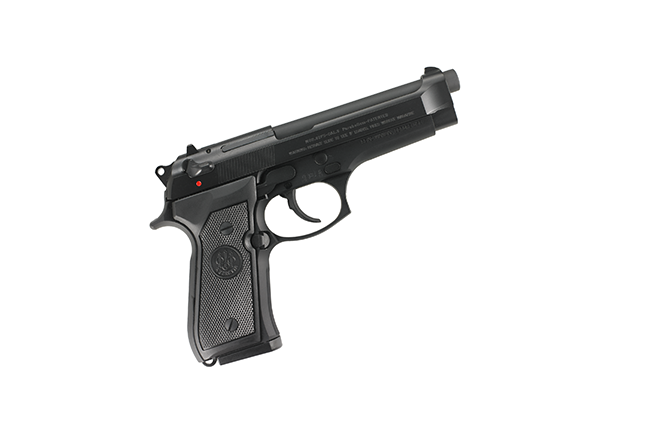
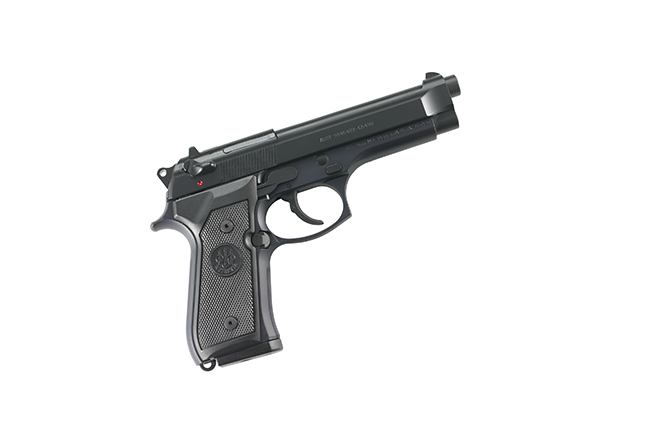
BONUS OFFER: Get your free shooting range targets to print at home!
Get your free targets to print at home!
Frame/Dust Cover
One noticeable difference between the M9 and the 92FS is the shape of their dust covers. The frame is the most noticeable visual difference between the two firearms. Unlike the M9’s flat dust cover, the 92FS has an inclined dust cover that extends in front of the trigger guard. This slanted design under the slide defines the front portion of the gun’s frame. Holsters specifically designed for the 92FS may not be suitable for the M9 due to this unique feature. Holsters made for it are one-of-a-kind.
Also, even if the gun fits in the holster, it might hinder a quick draw. It’s essential that your firearm fits snugly in the holster while facilitating a clean and swift draw when necessary. Remember this when choosing between the Beretta M9 and the 92FS.
Magazine
The 92FS and the M9 both have a standard capacity of 15 rounds of ammunition. Additionally, magazines for the M9 are available in capacities ranging from 15 to 18 rounds. Beretta factory magazines come in 10, 15, or 17 rounds, and aftermarket companies like Mec Gar produce magazines holding 18 to 20 rounds, assuming no legal restrictions apply in your state.
Grip
For those of you that know handguns, you know the grip is a big deal. Even a slight difference in shape or texture can make a huge difference in your feel of the firearm. When comparing these two firearms, a notable distinction lies in their grip configurations. In the 92FS, you’ll observe a narrower handle that forms a distinct arc towards the beavertail. For those unfamiliar, the beavertail refers to the flared end beneath the hammer. In contrast, the M9 features a broader grip with a less pronounced arc.
In comparison, I prefer the 92FS. Its narrower handle allows for a firmer grip, enhancing control while firing and managing recoil. Many users find that a smaller handle results in more precise follow-up shots, although this may vary depending on the shooter’s hand size. Moreover, there are several replacement grips available for customization.
Markings
I don’t focus on small details like the markings. But when reviewing the 92FS versus the M9 there is not a long list of differences. The Beretta M9 serves as the primary sidearm for the US military, hence each gun is stamped with “U.S. 9mm M9 Beretta U.S.A.” on one side and the serial number on the other. In contrast, the Beretta 92FS displays the country of origin with the serial number below and “MOD. 92FS-CAL 9MM Parabellum” on the opposite side. These distinctions may seem minor, but they matter to those aware of the M9’s military use compared to civilian models.
Accuracy
This isn’t a difference but worth mentioning. The actual test for a tactical gun’s usefulness would be at the shooting range. The M9 proves to be highly accurate on the range and performs exceptionally well. Both the M9 and 92FS can achieve 10-shot groups of 3 inches or less at approximately 50 meters, based on official testing criteria. That’s roughly 55 yards, demonstrating reliability and precision. This level of match-grade accuracy is impressive, ensuring consistent performance shot after shot by Beretta. It sets the 92FS and M9 apart, as many other top-tier handguns require costly and time-intensive upgrades to achieve such precision. Undoubtedly, these pistols deliver exceptional accuracy straight out of the box!

Cost
The retail price of a Beretta 92FS pistol is currently $699 at the time of writing. Whereas the Beretta M9 retail price is $649. There is a small difference in the price range that you will hardly notice. The retail price of the 92FS Inox is $775, which is reasonable. It is made of stainless steel and is the result of upgrades. However, anything you get is worth the money because it isn’t too pricey. No wonder it is preferred by many law enforcement services. No pistol on the market today is as tough, reliable, safe, or accurate as the Beretta M9. As a result, this handgun has gained the label, World Defender.
Conclusion
As always, I want to emphasize that choosing a firearm is a personal decision. It’s crucial to try out both options before making a purchase. Personally, in the debate between the Beretta M9 and the 92FS, I lean towards the 92FS. The main reasons are straightforward: I have smaller hands, and the 92FS’s compact grip design significantly improves my control. Achieving tight groupings when emptying a magazine is important to me, and the 92FS meets this requirement well. Moreover, it simply feels better in my hand. There is nothing that can replace that perfect feel when you grip a handgun.
Another obvious advantage of the 92FS is that it will not smack me in the face. First, I know the odds are small that it would happen, but the idea that the M9 would let the slide fly back in my face is an unsettling one. I like my face. I do not want to see it get messed up by my handy sidearm. The 92FS’ hammer pin will ensure that this never happens.
Personally, I favor the three-dot sight system of the 92FS. Sight systems often play a crucial role in my handgun selection process. If I raise the firearm and struggle to acquire my target, it’s a deal-breaker for me. While aftermarket sights are an option, I prefer investing in a gun that performs well out of the box. This preference for sight systems is more personal to me than any other aspect of the firearm.
The 92FS was developed as an enhancement over the M9. While improvements don’t always pan out, in this instance, the upgrade is notably effective. When investing my hard-earned money, this aspect reassures me about my purchase decision. While it’s true that these firearms share many similarities, when comparing the Beretta M9 to the 92FS, my preference leans towards the 92FS.
Related Articles
- The 10 Best .45 Pistols
- Best 10mm Pistols & Handguns: Carry some POWER!
- Best 1911 Pistols For The Money
Updated: July 2024

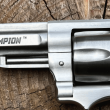

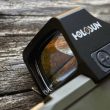

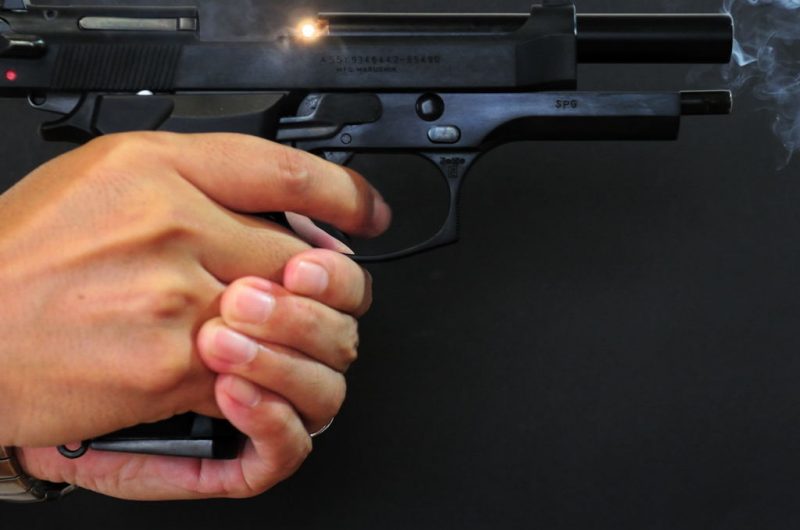




![9mm Glock Models [Ultimate Guide]](https://www.snipercountry.com/wp-content/uploads/2018/10/Glock-17-vs-Glock-19-vs-Glock-26-vs-Glock-41-vs-Glock-43-WM-400x250.jpg)
![Handgun Caliber Chart [2025 Ultimate Guide]](https://www.snipercountry.com/wp-content/uploads/2018/10/Handgun-Caliber-Comparison-400x250.jpg)
![Rifle Calibers [Ultimate Guide]](https://www.snipercountry.com/wp-content/uploads/2018/12/Header-1900-400x250.jpg)






My 92f was purchased in 1986 after I learned they won the military contract. It was made in Italy. Does that fact (Italy cause it to be worth any more?
PS I am absolutely impressed with the level of detail in your description of absolutely everything
I don’t have an M9 to compare but i do have the 92FS, the M9A1, and the 96 (40cal.). I do not feel much difference in the grip. Maybe the 92 is a bit smaller but I dont see it. Iwould have to get an instrument to measure it. The wt. difference with a 10 shot mag. ( i live in CA) is negligible. Other than Caliber in the 96 and the Picatinny rail on the frame of the M9A1 I do not see much difference in the three. I do love shooting them equally. My 92FS is also made in Italy the M9A1 and the 96 both made in US.
Thanks for the comparison. I’m looking at the M9A3 but they are more expensive than the 92FS and I can’t see much difference. I prefer the FS because I want the dual ambidextrous safety/decocker. One thing about your review that is different than just about everyone else is that you didn’t the trigger. Are there significant differences in the triggers? over travel, reset, pull weights, stacking, smoothness? We all want the best trigger without paying to have custom trigger jobs. Please comment, thanks.
Only early versions do not have the enlarged hammer pin. The current M9 is safe.
Well written review. Helped me in making my decision, and that’s what I was looking for.
I have an M9A1 and a 92FS although I have to admit the 92 is a Wilson Combat pistol. Mostly, I can not find the differences that you discuss. I can not speak for the hammer as both of mine have skeletonized hammers installed. However, my M9 has 3 dot sights like the 92FS and it came that way. It is an M9A1 but it does say 92FS on the opposite side. I also can not speak about the dust cover as both of mine have the rail on them under the front of the slide. The rail on the 92 is longer that the one on the M9 but I think this is a Wilson modification. Both of my frames seem to be exactly alike, I can find no differences either visually or by feel. The Wilson Combat came with VZ G10 grips and I put the same ones on the 92FS. They both feel exactly the same to me. My M9 markings are different than you discuss. On the left side slide it says Beretts USA Corp ACKK MD – Made In USA. On the slide under that it says BERXXXXX Type M9A1. On the opposite side on the frame it says MOD. 92FS-CAL. 9mm Parabellum Patented. The Wilson Combat says almost the same on all places other than on the left side slide the place of manufacture is changed to Gallatin, TN and the S/N starts with WCXXX. On the other side of the pistol it says 92G Brigadeer Tactical instead of 92FS. Also the 92 came with the decocker only and not a safety/decocker. One strange difference with them is I go to the range with a friend of mine and we run out a target. With the Wlson I usually shoot at the manufactures symbol in the corner instead of the target, it shoots that well for me. My friend shooting it for some reason can barely get them inside the target circle. We change to the M9 and it is almost exactly the opposite. One pistol shoots very well for me and not so much for him and the other is the reverse. The only real difference that I know of is the 92 has a steel trigger with grooves cut into it. In reading the Wilson Combat website about the pistols that they build, when they get the parts from Beretta they do get the M9A1 frame and the 92G slide which could explain a lot of these differences. The only thing that I don’t like about the 92 is that Wilson puts their Wilson Combat rear u-notch battlesight on it that has no dots whatsoever making it difficult to see in low light situations. Anyway, for me the comparison is no contest, I love the 92G but it is an enhanced pistol that cost almost twice what a normal Beretta costs so it better be the one I favor.
Small arms solutions has an excellent video explaining the slide failures. I own a m9 and its my favorite 9mm in my collection right now. That will change as soon as berretta gets moving on my briggadier inox that has been on order for 8 months. The slide to the face was not as common as many made it out to be
Great artical
Buy the Italian 92fs at Academy Sports. $600; both 2 there.
Sorry bought 2 NOT both.
Beretta M9 is one of the best from others as per my experience.